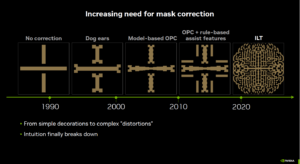Manufacturing-related innovations make up a large part of this week’s news roundup. Arm vs Risc-V is also a theme, with the open-source ISA gaining ground in China while Arm’s IP is reportedly set to become more expensive.
Nvidia cuts processing time for computational lithography
The new Nvidia cuLitho software library for computational lithography promises to slash the time and energy required to produce photomasks. Mask manufacturing at advanced nodes requires a vey complex compensation of the pattern distortions caused by the diffraction of light or EUV rays. Simplistically explained, the compensation is essentially obtained by transforming the design polygons into complex shapes, so that the combined effect of these shapes and diffraction will eventually result in the desired polygons being projected on the resist. This transformation – an example of computational lithography – is obviously carried out by software running on a processing platform. With large chips now containing several dozen billion transistors, foundries working on advanced nodes need large datacenters to perform computational lithography. As we learn from Jensen Huang’s keynote given at this year’s GTC event, TSMC is currently using a 40,000 CPU server farm for computational lithography, absorbing 35 megawatts. With cuLitho, and running all parts of the computational lithography process in parallel, the workload can be handled by just five hundred Nvidia DGX H100 GPU-based systems, reducing power to ‘just’ 5 megawatts. According to Nvidia, in the near term, fabs using cuLitho could produce each day 3-5x more photomasks using 9x less power than current configurations. A photomask that required two weeks can now be processed overnight.








